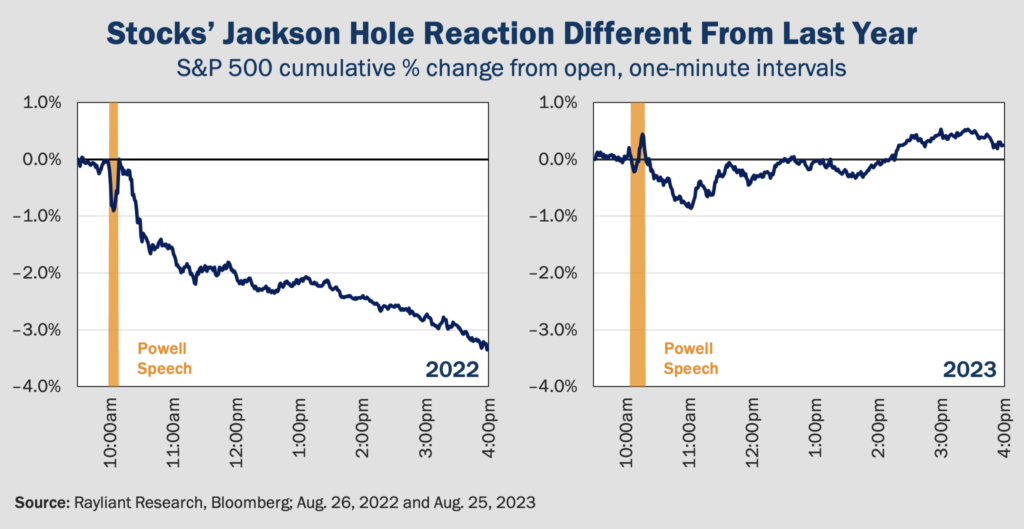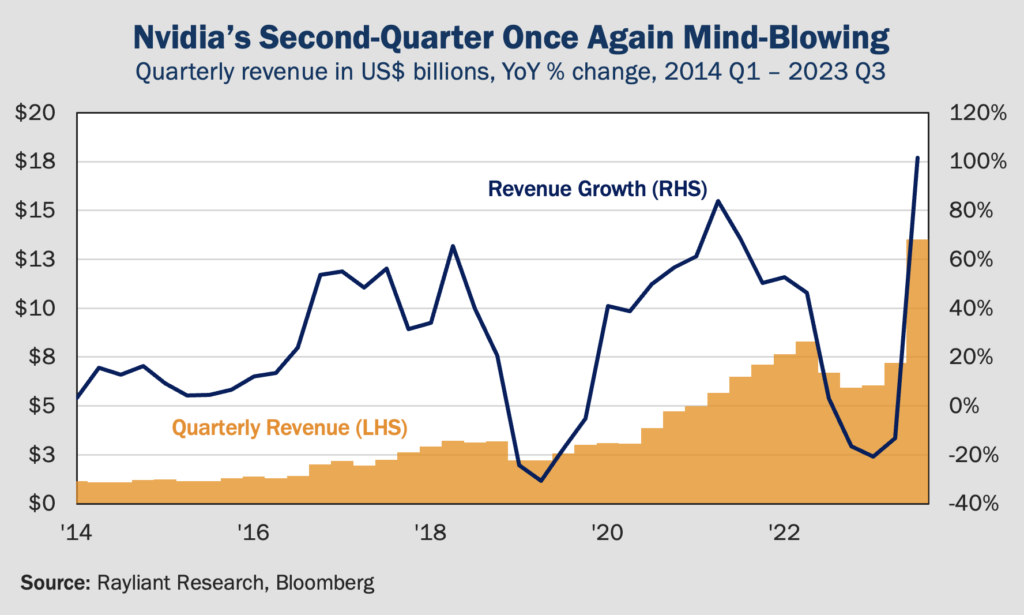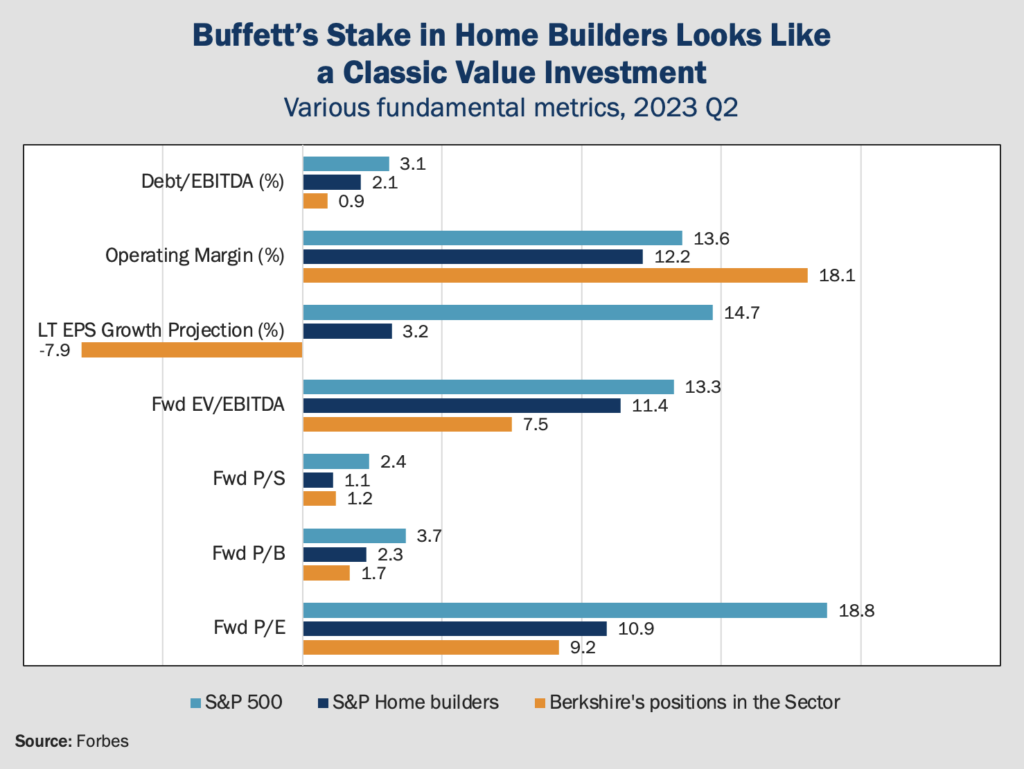
Powell reaffirms 2% inflation target
When Fed chair Jerome Powell began his speech on Friday morning in Jackson Hole, Wyoming—that well-known venue for the Kansas City Fed’s annual summer symposium to discuss monetary policy—he killed any suspense in the first few lines, stating very bluntly: “It is the Fed’s job to bring inflation down to our 2% goal, and we will do so.” While acknowledging the bank has made some progress on inflation since rate hikes began, it was clear from Powell’s commentary that additional rate hikes are on the table. Again, reading from the first paragraph of his remarks, US central bankers are “prepared to raise rates further if appropriate, and intend to hold policy at a restrictive level until we are confident that inflation is moving sustainably down toward our objective.” For those expecting rate cuts a few months from now, that’s not great news. Glass half full, it’s reassuring to hear Powell boast about the Fed being “in a position to proceed carefully as we assess the incoming data.” The problem comes if data show inflation isn’t coming down fast enough.
Reaction in stocks was muted
One nice thing about Jackson Hole is that because the market is open, we get to see how investors process the central bank’s message in real time, which we plot below. Some might remember Powell’s Jackson Hole speech one year ago: a grim statement of the Fed’s hawkish intentions, which unsurprisingly tanked the market. The initial reaction as the Fed chair started speaking in 2022 was negative, though investors warmed to his remarks as he wrapped up, only to sell like crazy as soon as the speech ended, sending the S&P 500 down over 3% by the close of trading. In response to this year’s speech, we see the same dip through the middle of Powell’s comments and the same negative reaction through the next hour. But, given half a day to digest the Fed chair’s remarks, the conclusion of equity investors was: no big deal. By noon, stocks were pretty much back to even for the day, hugging ‘unchanged’ for the rest of the session before closing modestly higher at 4:00 pm.

So, what did we learn?
In one sense, we agree with the market: Powell didn’t throw any curveballs here, and ‘no news’ shouldn’t elicit a big reaction. We already understood the Fed isn’t happy with core inflation at 4.7%, and we already accepted there could be additional hikes this year. We certainly weren’t banking on rate cuts in 2023. All Powell did in his short Jackson Hole speech was to preserve the bank’s flexibility, while reiterating they’re dead serious about stamping out inflation. We shouldn’t expect they’ll get comfortable with something higher than 2% or that they’ll take our current progress as a sure enough sign we’ll get back down to 2% in the long run. Policy is going to remain restrictive, and that means a soft landing—although more likely now than it was a year ago—is still no guarantee. Fed funds futures traders apparently did learn something last Friday, as the chances of another rate increase by year end moved from 46% before Powell spoke to 54% at Friday’s close. Consensus expectations for when easing starts remain around mid-2024, at the earliest. The issue we have with equity valuations is that after falling almost 4% in August, the S&P 500 still doesn’t seem to be pricing the ‘higher for longer’ view expressed in Powell’s Jackson Hole remarks. As such, we remain defensive.
AI chipmaker posts another stellar quarter
If Nvidia had reported its earnings at 10am on Friday, we suspect Powell might have been preaching Fed policy to an empty room in Jackson Hole. Such has been the level of interest in the chipmaker’s fortunes since earlier this year, when an AI craze drove stock investors into a frenzy and led the company’s shares to almost triple in value through the beginning of last week. Thankfully, nobody had to miss Powell’s speech, as Nvidia delivered its results after the market closed last Wednesday—and the numbers were nothing short of spectacular. Sales in the second quarter more than doubled year-over-year to $13.5 billion (see below), while EPS jumped 429% from a year ago. The firm’s Q2 gross profit margin was a whopping 70.1%, up from 43.5% in Q2 2022. Nvidia’s guidance was also promising, with a projection for Q3 revenues of $16 billion, up from $5.9 billion the previous year, and exceeding the $12.5 billion consensus by a wide margin. If there was any question about momentum in the company’s fundamentals, second-quarter results answered those.

What did this mean for investors?
Given the astonishing growth reflected in Nvidia’s Q2 earnings, it might have come as a shock to some that the stock’s reaction, the day after this announcement, was to close up less than 0.1%: effectively flat. The conclusion, of course, is that the company’s results, astonishing as they are, were already priced into the shares. One of the most challenging aspects of stock valuation is putting a price on growth stocks. For a company like Nvidia, investors are willing to pay a price-to-sales ratio of 35x for the stock—versus a mere 2.5x for the S&P 500 index—because they believe the company will grow sales fantastically in the future. Last quarter’s growth in sales was amazing, but ‘amazing’ is what it will take to justify NVDA’s current valuation.
Analysts see upside, but risks loom
That’s not to say the stock doesn’t have upside: Analysts’ 12-month consensus price target for NVDA is around $630 per share, nearly 38% higher than its closing price of $460 last Friday. But investors must appreciate the risk of disappointment when hopes are so high. Indeed, part of the risk to Nvidia’s stock is that AI excitement fades and macro headwinds begin to hit harder. In the aftermath of great earnings, anxiety over Jackson Hole, a surprisingly large drop in weekly initial jobless claims, and a greater-than-expected decline in durable goods orders undoubtedly weighed on NVDA’s post-earnings trading.
New builds still beating existing homes
The National Association of Realtors released data on the health of the US housing market last Tuesday, showing inventory constraints continue to push buyers from the resale market into the new home segment. July existing home sales fell 2.2% from June, amounting to a seasonally adjusted 16.6% year-over-year drop. Although the inventory of existing homes on the market increased by 3.7% from June to July, that was still 14.6% lower than the inventory a year ago. By contrast, new home sales surpassed expectations in July, rising 4.4% for the month, or 31.5% year-over-year, to reach a 17-month high. Even with mortgage rates pushing upward of 7% last week, growth in US household formation is outpacing construction, providing support for prices.
Buffett betting on homebuilders
All of this is naturally music to homebuilders’ ears. We suspect it also explains why Warren Buffett, according to Berkshire Hathaway’s recent 13F filing, plowed over $800 million into three US homebuilders in Q2, a period over which the legendary investor was a net seller of stocks. The bulk of Berkshire’s investment was in DR Horton shares, with smaller sums allocated to NVR and Lennar. Even a superficial look at the companies’ fundamentals via Forbes (see below) reveals the stake to be typical of Buffett’s value investment style: cheap companies with strong profitability.

Major homebuilders like DR Horton also fit Berkshire’s playbook, as they enjoy benefits over fragmented local competitors, with significant advantages in things like securing land, sourcing materials, and managing inventory. And then there are the favorable industry trends mentioned above, which DR Horton’s own CEO, David Auld, confirmed to Fortune in June, remarking that the market for both new and existing homes remains “extremely undersupplied” and that he expects the condition will persist “likely for years to come due to development and construction capacity constraints in the industry.”
You are now leaving Rayliant.com
The following link may contain information concerning investments, products or other information.
PROCEED